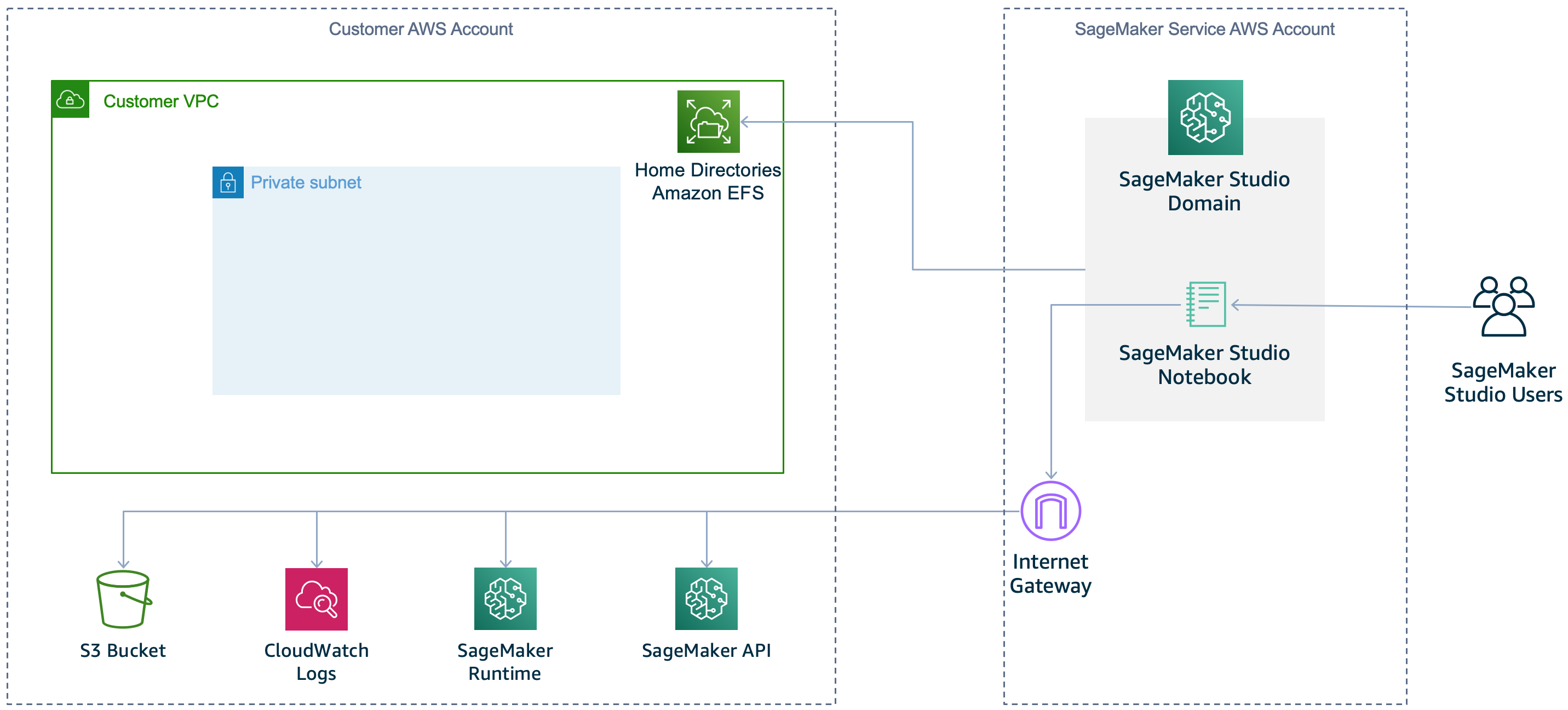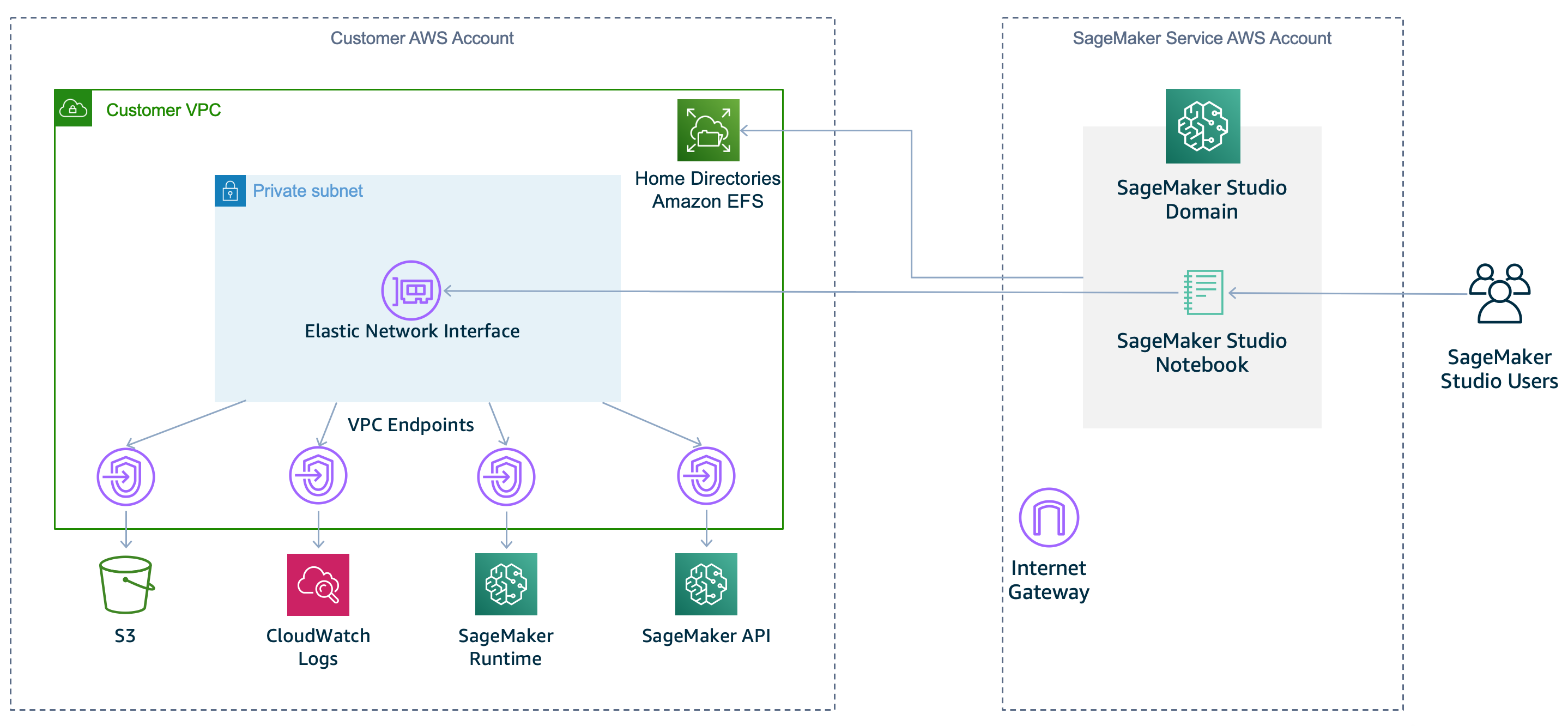Connect Studio notebooks in a VPC to external resources
The following topic gives information about how to connect Studio Notebooks in a VPC to external resources.
Default communication with the internet
By default, SageMaker Studio provides a network interface that allows communication with the internet through a VPC managed by SageMaker AI. Traffic to AWS services, like Amazon S3 and CloudWatch, goes through an internet gateway. Traffic that accesses the SageMaker API and SageMaker AI runtime also goes through an internet gateway. Traffic between the domain and Amazon EFS volume goes through the VPC that you identified when you onboarded to Studio or called the CreateDomain API. The following diagram shows the default configuration.

VPC only
communication with the internet
To stop SageMaker AI from providing internet access to your Studio notebooks, disable
internet access by specifying the VPC only network access type. Specify
this network access type when you onboard to Studio or
call the CreateDomain
API. As a result, you won't be able to run a Studio notebook unless:
-
your VPC has an interface endpoint to the SageMaker API and runtime, or a NAT gateway with internet access
-
your security groups allow outbound connections
The following diagram shows a configuration for using VPC-only mode.

Requirements to use VPC only mode
When you choose VpcOnly, follow these steps:
-
You must use private subnets only. You cannot use public subnets in
VpcOnlymode. -
Ensure your subnets have the required number of IP addresses needed. The expected number of IP addresses needed per user can vary based on use case. We recommend between 2 and 4 IP addresses per user. The total IP address capacity for a Studio domain is the sum of available IP addresses for each subnet provided when the domain is created. Make sure that your IP address usage isn't more than the capacity supported by the number of subnets you provide. Additionally, using subnets distributed across many availability zones can help with IP address availability. For more information, see VPC and subnet sizing for IPv4.
Note
You can configure only subnets with a default tenancy VPC in which your instance runs on shared hardware. For more information on the tenancy attribute for VPCs, see Dedicated Instances.
-
Warning
When using
VpcOnlymode, you partly own the networking configuration for the domain. We recommend the security best practice of applying least-privilege permissions to the inbound and outbound access that security group rules provide. Overly permissive inbound rule configurations could allow users with access to the VPC to interact with the applications of other user profiles without authentication.Set up one or more security groups with inbound and outbound rules that allow the following traffic:
-
NFS traffic over TCP on port 2049 between the domain and the Amazon EFS volume.
-
TCP traffic within the security group. This is required for connectivity between the Jupyter Server application and the Kernel Gateway applications. You must allow access to at least ports in the range
8192-65535.
Create a distinct security group for each user profile and add inbound access from that same security group. We do not recommend reusing a domain-level security group for user profiles. If the domain-level security group allows inbound access to itself, all applications in the domain have access to all other applications in the domain.
-
-
If you want to allow internet access, you must use a NAT gateway with access to the internet, for example through an internet gateway.
-
To remove internet access, create interface VPC endpoints (AWS PrivateLink) to allow Studio to access the following services with the corresponding service names. You must also associate the security groups for your VPC with these endpoints.
-
SageMaker API :
com.amazonaws.region.sagemaker.api -
SageMaker AI runtime:
com.amazonaws.. This is required to run Studio notebooks and to train and host models.region.sagemaker.runtime -
Amazon S3:
com.amazonaws..region.s3 -
To use SageMaker Projects:
com.amazonaws..region.servicecatalog -
Any other AWS services you require.
If you use the SageMaker Python SDK
to run remote training jobs, you must also create the following Amazon VPC endpoints. -
AWS Security Token Service:
com.amazonaws.region.sts -
Amazon CloudWatch:
com.amazonaws.. This is required to allow SageMaker Python SDK to get the remote training job status from Amazon CloudWatch.region.logs
-
Note
For a customer working within VPC mode, company firewalls can cause connection issues with SageMaker Studio or between JupyterServer and the KernelGateway. Make the following checks if you run into one of these issues when using SageMaker Studio from behind a firewall.
-
Check that the Studio URL is in your networks allowlist.
-
Check that the websocket connections are not blocked. Jupyter uses websocket under the hood. If the KernelGateway application is InService, JupyterServer may not be able to connect to the KernelGateway. You should see this problem when opening System Terminal as well.